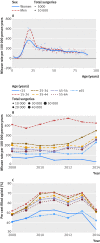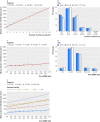Postsurgical prescriptions for opioid naive patients and association with overdose and misuse: retrospective cohort study
- PMID: 29343479
- PMCID: PMC5769574
- DOI: 10.1136/bmj.j5790
Postsurgical prescriptions for opioid naive patients and association with overdose and misuse: retrospective cohort study
Abstract
Objective: To quantify the effects of varying opioid prescribing patterns after surgery on dependence, overdose, or abuse in an opioid naive population.
Design: Retrospective cohort study.
Setting: Surgical claims from a linked medical and pharmacy administrative database of 37 651 619 commercially insured patients between 2008 and 2016.
Participants: 1 015 116 opioid naive patients undergoing surgery.
Main outcome measures: Use of oral opioids after discharge as defined by refills and total dosage and duration of use. The primary outcome was a composite of misuse identified by a diagnostic code for opioid dependence, abuse, or overdose.
Results: 568 612 (56.0%) patients received postoperative opioids, and a code for abuse was identified for 5906 patients (0.6%, 183 per 100 000 person years). Total duration of opioid use was the strongest predictor of misuse, with each refill and additional week of opioid use associated with an adjusted increase in the rate of misuse of 44.0% (95% confidence interval 40.8% to 47.2%, P<0.001), and 19.9% increase in hazard (18.5% to 21.4%, P<0.001), respectively.
Conclusions: Each refill and week of opioid prescription is associated with a large increase in opioid misuse among opioid naive patients. The data from this study suggest that duration of the prescription rather than dosage is more strongly associated with ultimate misuse in the early postsurgical period. The analysis quantifies the association of prescribing choices on opioid misuse and identifies levers for possible impact.
Published by the BMJ Publishing Group Limited. For permission to use (where not already granted under a licence) please go to http://group.bmj.com/group/rights-licensing/permissions.
Conflict of interest statement
Competing interests: All authors have completed the ICMJE uniform disclosure form at www.icmje.org/coi_disclosure.pdf and declare: no support from any organization for the submitted work; no financial relationships with any organizations that might have an interest in the submitted work in the previous three years; no other relationships or activities that could appear to have influenced the submitted work.
Figures




Comment in
-
Duration of Postoperative Opioid Use Predicts Misuse More Than Dosage.Am J Nurs. 2018 Apr;118(4):15. doi: 10.1097/01.NAJ.0000532059.04653.20. Am J Nurs. 2018. PMID: 29596241
References
-
- Elzey MJ, Barden SM, Edwards ES. Patient Characteristics and Outcomes in Unintentional, Non-fatal Prescription Opioid Overdoses: A Systematic Review. Pain Physician 2016;19:215-28. www.ncbi.nlm.nih.gov/pubmed/27228510. - PubMed
-
- Centers for Disease Control and Prevention (CDC) Vital signs: overdoses of prescription opioid pain relievers---United States, 1999--2008. MMWR Morb Mortal Wkly Rep 2011;60:1487-92. - PubMed
MeSH terms
Substances
LinkOut - more resources
Full Text Sources
Other Literature Sources
Medical
